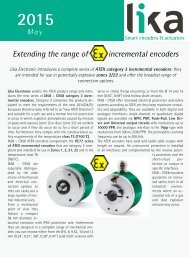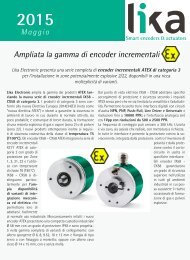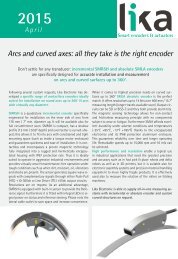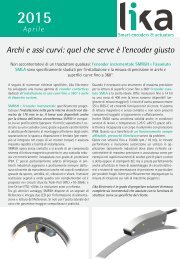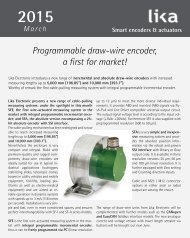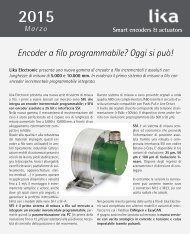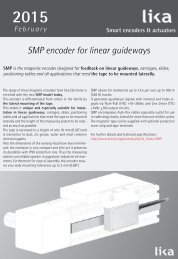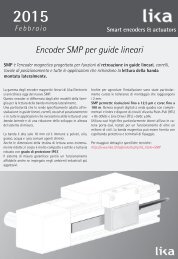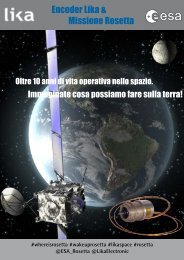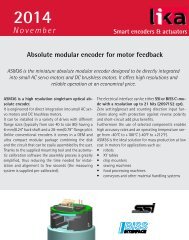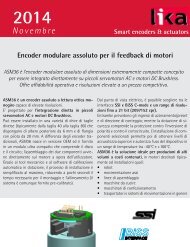LINEPULS & LINECOD catalogue 2016 in English
Lika Electronic incremental and absolute linear encoders catalogue 2016 in English Our new linear encoders catalogue is out now, and features many innovative new products and up-to-date information. The catalogue is expressly designed to set out the comprehensive range of incremental & absolute linear encoders from Lika Electronic. Check it out, it is completely renewed! Make sure you don’t miss out on a copy, download the pdf file from our web site or request your hard copy now! We have also got an interactive digital version in the works that shall be released soon!
Lika Electronic incremental and absolute linear encoders catalogue 2016 in English
Our new linear encoders catalogue is out now, and features many innovative new products and up-to-date information. The catalogue is expressly designed to set out the comprehensive range of incremental & absolute linear encoders from Lika Electronic. Check it out, it is completely renewed!
Make sure you don’t miss out on a copy, download the pdf file from our web site or request your hard copy now!
We have also got an interactive digital version in the works that shall be released soon!
You also want an ePaper? Increase the reach of your titles
YUMPU automatically turns print PDFs into web optimized ePapers that Google loves.
<strong>LINECOD</strong><br />
Output circuits and fieldbus <strong>in</strong>terfaces<br />
First developed <strong>in</strong> the automotive <strong>in</strong>dustrial sector, CANbus (Controller Area Network)<br />
serial bus system has thereafter established itself <strong>in</strong> a variety of <strong>in</strong>dustrial applications,<br />
<strong>in</strong> particular where noisy electrical environment conditions could lead to unsafe communication.<br />
International Organization for Standardization (ISO) has established the CAN standard <strong>in</strong><br />
ISO 11898, develop<strong>in</strong>g the protocol over the first two layers of the ISO/OSI (Open Systems<br />
Interconnection) reference model; while all the other protocol layers are the network designer’s<br />
choice. Unlike other protocols that def<strong>in</strong>e all ISO/OSI layers, developers <strong>in</strong>tentionally<br />
limited the CAN specifications so manufacturers are free to choose a specific implementation<br />
of the higher protocol layers; for this reason other CAN-based protocols have been<br />
developed at higher layers as CANopen and DeviceNet or other proprietary protocols.<br />
CANbus standard and CANopen communication protocol are adm<strong>in</strong>istered by CAN <strong>in</strong> Automation<br />
(www.can-cia.org). CANopen is widely used <strong>in</strong> Europe.<br />
CANopen is a CAN-based communication protocol which implements the higher layers of<br />
the ISO/OSI (Open Systems Interconnection) reference model. Its technology development<br />
and standardization are entrusted to CiA (CAN <strong>in</strong> Automation).<br />
CANopen is a S<strong>in</strong>gle Master - Multi Slave communication protocol. Master device is able<br />
to detect all the Slaves connected to the network thanks to the EDS (Electronic Datasheet)<br />
configuration file which is provided by the device manufacturer. The EDS file conta<strong>in</strong>s the<br />
complete list of all the work<strong>in</strong>g parameters of the Slave device and <strong>in</strong>formation for configur<strong>in</strong>g<br />
the communication between the Master and the Slave.<br />
In the CANopen network, the Master device must be addressed to 0, while the Slave nodes<br />
have address between 1 and 127. Maximum transmission rate is up to 1Mbit/s.<br />
The follow<strong>in</strong>g table shows the maximum transmission rates <strong>in</strong> relation to permissible l<strong>in</strong>e length.<br />
Baud rate<br />
[Kbit/s]<br />
Max. cable<br />
length<br />
10 20 62.25 125 250 500 800 1000<br />
5000 m<br />
16400 ft<br />
2500 m<br />
8200 ft<br />
1000 m<br />
3300 ft<br />
500 m<br />
1650 ft<br />
250 m<br />
820 ft<br />
100 m<br />
330 ft<br />
50 m<br />
165 ft<br />
30 m<br />
100 ft<br />
Lika encoders with CANopen <strong>in</strong>terface comply with the “Device Profile for encoders” Class 2<br />
established <strong>in</strong> the “CIA Draft Standard 301” and the “CIA Draft Standard 406” publications.<br />
Lika devices with CANopen support the CANopen network management (NMT) slave state<br />
mach<strong>in</strong>e (Initialization state, Pre-operational state, Operational state, Stopped state) and<br />
use COBs (Communication Objects), <strong>in</strong> particular: NMT (Network Management) messages to<br />
issue state mach<strong>in</strong>e change commands (i.e. to start and stop the devices) and detect remote<br />
device boot-ups and error conditions; PDO (Process Data Object) messages to process real<br />
time data (transmission of process data <strong>in</strong> real time); and SDO (Service Data Object) messages<br />
to set and read values from the “Object dictionary” of the remote device. Furthermore<br />
they implement some standard objects such as the synchronization object (SYNC) and the<br />
Nodeguard<strong>in</strong>g. Among the parameters available: position readout, count<strong>in</strong>g direction, scal<strong>in</strong>g<br />
function, preset and offset values, two m<strong>in</strong>. and max. software limit switches, errors<br />
register and diagnostic <strong>in</strong>formation. Encoders can be fitted with diagnostic LEDs and bus<br />
term<strong>in</strong>ation resistance.<br />
CANopen at a glance<br />
Number of<br />
stations<br />
Sett<strong>in</strong>g the<br />
nodes<br />
Sett<strong>in</strong>g the<br />
baud rate<br />
Transmission<br />
rate<br />
Cable length<br />
Cable<br />
Up to 127<br />
Dip switches<br />
or software<br />
Dip switches<br />
or software<br />
Up to<br />
1Mbit/s<br />
Up to 5000 m/<br />
16400 ft<br />
Standard CANopen/<br />
M12 connectors<br />
46




